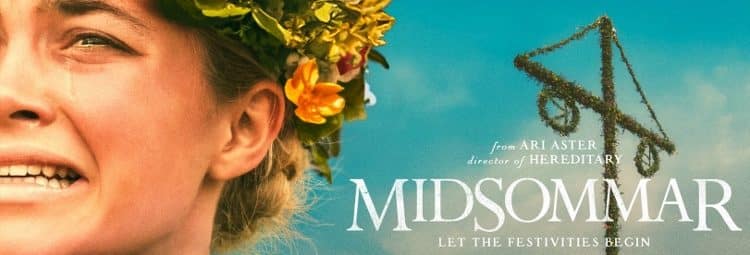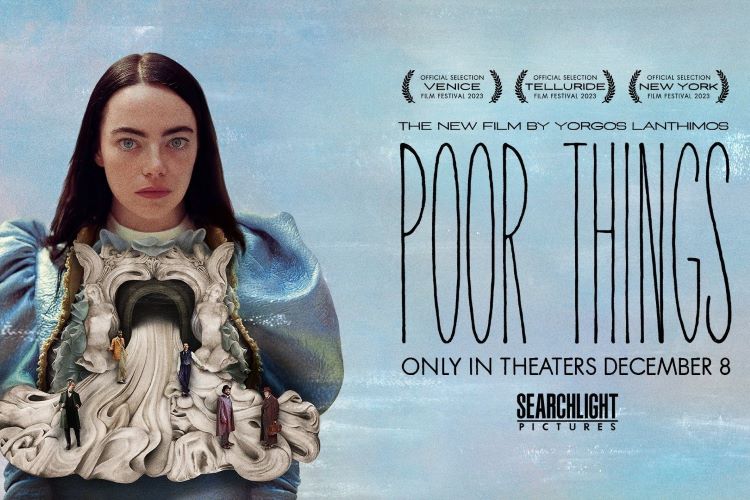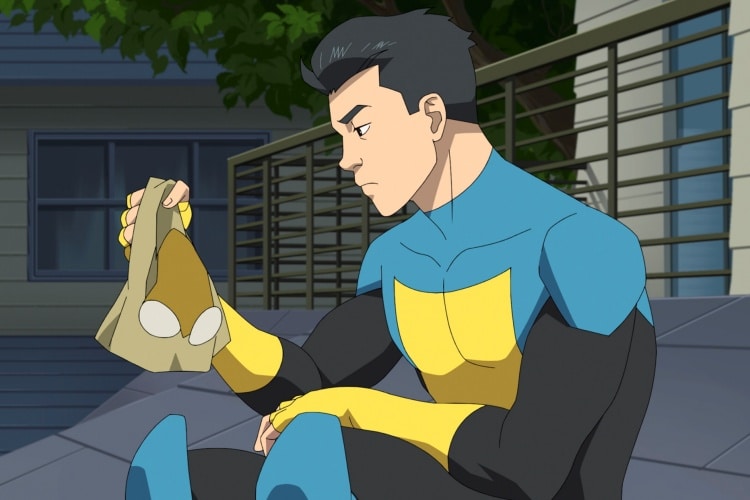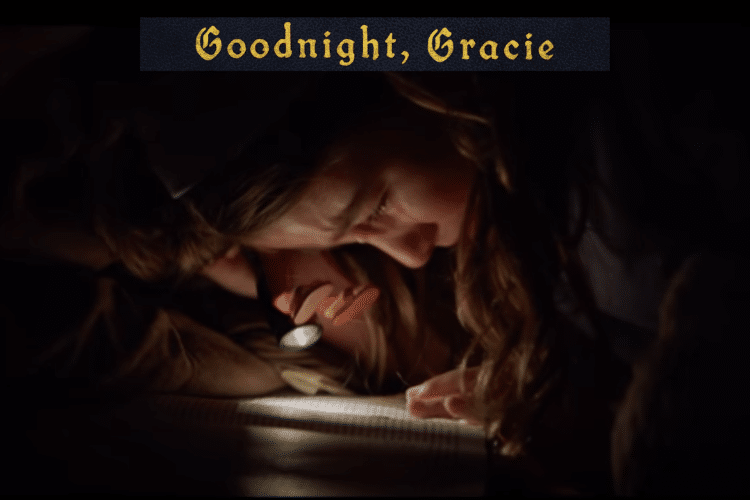SMILES OF A SUMMER NIGHT
Main Cast: Florence Pugh, Jack Reynor
Director: Ari Aster
Today was the big day. We have just finished our Das Rheingold portion of our on-location Ring Cycle, performed live on the River Rhine in Southern Germany. For the most part it went pretty well. There were several minor technical glitches as there always are on a production of this magnitude. The cord for my bungee jump from the top of the Lorelei rock into the Rhine waters where the synchronized swimmers were doing a lovely water ballet around the Rhine maidens was not calibrated quite correctly so rather than kissing the surface and joining the pattern, I went plummeting to the bottom where my Valkyrie horns got stuck in the mud and both helmet and wig came off. I surfaced with a torn wig cap and mud all down one side of my beautifully made up face (Lesterene brand waterproof makeup for the active woman) but I was able to gracefully grab a piece of floating detritus and quickly fashion a cunning little beret, so I don’t think anybody much noticed. The rainbow bridge also malfunctioned so Wotan ended up having to lead the gods down the rack to the port-a-potties rather than to Valhalla but after three hours, most of the audience were playing Words with Friends on their phones so it wasn’t too big of a faux pas. I had forgotten quite how long this show is in performance. I may have to speak to DeWolfe S. Tod of Totestadt productions about making some judicious trims in the other three parts in order to hold our audience interest.

We move on to Die Walkure tomorrow where I, as Brunhild am laid to rest on a rocky crag surrounded by flames. In a supreme casting coup, we’ve gotten James Earl Jones to play Wotan. He’s gotten to be a little older, so we had to find a rocky crag with sure footing and plenty of places to sit down so we’re using the Niederwalddenkmal. The pyrotechnic effects promise to be quite stunning and it’s far enough back from the trees to keep us from having any accidental flaming forests during this unseasonably hot German summer. Kim Dee and Mary Gee, my incredibly talented costumiers, have come up with a gorgeous silver lame dress, backless and cut along the bias which will absolutely shine in the firelight. We’ve timed it out, so we’ll reach this climax at twilight and in the long shots, I’ll look just like rising of the evening star. A too kind critic once called me a shimmering star in the cinema firmament, and I like to prove such words literal truth.
Our floating hotel is tied up this evening to a pier in the town of Bingen, once home of Hildegarde, one of my personal heroines after whom I have tried to model myself in all things. The town has changed a bit since the 12th century when she was here as I don’t think the Bingen cineplex had yet been constructed but that’s where I found myself at the end of my walk down the quaint cobblestone streets. As my head has been so full of Germanic and Norse pagan mythology what with the current project, I decided that my best choice of evening entertainment would be the new film from director Ari Aster, Midsommar. Mr. Aster made a bit of a splash last year with his first major release, Hereditary, and I was curious as to how he did on his sophomore outing.
Midsommar follows the old horror trope of a group of naïve young people heading into dangers which they do not recognize and for which they are ill prepared. Usually films of this type are full of actors recruited from the Century City Gold’s Gym who are disposed of in ghastly ways by the other, whether they be an isolated family of freaks (The Texas Chainsaw Massacre), a primitive tribe (The Green Inferno), or ravenous beasties of some sort (more films than I care to name). They follow a formula of dark shadows, boo moments, and gouts of artificial blood. Mr. Aster has taken great pleasure at turning much of this on its head. His film concerns the requisite group of young people, but these aren’t interchangeable models but rather real, imperfect people with ordinary bodies and significant problems. The failing relationship at the center of the film between college student Dani (Florence Pugh) and her boyfriend Christian (Jack Reynor) is more central to the proceedings than the macabre elements and provides the narrative thrust and ultimately the psychological reasons why things happen the way that they do. Aster also disorients us by setting his film in midsummer Sweden (although it was actually filmed in Hungary outside of Budapest). It’s the land of the midnight sun and the lovely bright glow and the radiant colors of the forests and fields lull us into thinking that nothing bad could truly be happening here. His others are all charming blond Scandinavians, dressed for a Gulf Coast wedding in lovely flowing linen frocks with flowers in their hair. This gives the film an incredibly unsettling tone and it stays with you long after the lights come up.
At the beginning of Midsommar, Dani suffers a terrible family tragedy. Christian, who is one of those millennial man babies that one tends to run into these days, is not really capable of helping her through her crisis and is much more interested in a planned trip to Sweden with his fellow grad students in anthropology. They are invited by Pelle (Vilhelm Blomgren), a Swede studying abroad who grew up in a communal group, the Harga, who keep some of the ancient folk traditions of pagan Scandinavia alive. Christian and his friends Josh (William Jackson Harper) and Mark (Will Poulter) all decide to go, hoping to find something interesting on which they can start doing their dissertation work and Dani tags along, to their annoyance. When they arrive in Sweden, they head out into the countryside, meeting up with Pelle’s brother Ingemar (Hampus Hallberg) who has also brought a couple of friends with him from England where he had been working, Simon (Archie Madekwe) and Connie (Ellora Torchia). The Harga are having a very special mid-summer celebration this year, one that only occurs every 90 years. At first everything is feasting, fun, and the occasional psilocybin mushroom, but then things begin to turn dark with ritual suicides, sudden disappearances, and it starts to occur to our outsiders that they’re miles from anywhere in the middle of nowhere and the natives may not be as friendly as they appear on the surface.
I shan’t reveal what happens to whom but it’s not Aster’s intention to surprise the audience as much as it is to instill feelings of unease and psychological dread. Midsommar starts out with a lovely and magical painting that more or less unfolds most of the plot if you look at it closely. All through the film, in the various buildings of the Harga village, the wall murals telegraph what’s to come if you look at them closely. The camera doesn’t linger on them in close up and connect the dots. Aster assumes his audience will be bright enough to do that on its own. The innate personality characteristics of each of the students – curiosity, indifference, neediness, is what leads to their various fates, all eventually coming together at the end in a flaming barn. Aster also wrote the screenplay. Some sources suggest that his original cut of the film was nearly four hours in length. The theatrical release is about two and a half. It never drags as it proceeds sure footedly towards its denouement but there are times where it feels like certain things, especially as pertains to the supporting players, are given short shrift.
Florence Pugh and Jack Reynor, in the central roles of Midsommar, are both excellent. Especially the former. She captures Dani’s grief and sullenness and pent up anger and when she makes her final decisions and takes her final actions, the shot of her smiling will not soon be forgotten. Reynor is very brave as an up and coming leading man. He has a rather lengthy full-frontal nude scene which is necessary for both plot and theme and the camera doesn’t play peek-a-boo coy drawing attention to what it’s not showing. Will Poulter is the best of the supporting cast as a douchebro who acts as a sort of comic relief. He’s come a long way since Eustace Grubb in The Voyage of the Dawn Treader. The cast of Scandinavians playing the villagers are all fine, but somewhat interchangeable. If you look closely, you can spot Bjorn Andresen who, as a teenager, played the luscious Tadzio in Death in Venice opposite Dirk Bogarde.
The painterly composition of many of the shots (cinematography by Pawel Pogorzelski) adds to the mood as there’s such a disconnect between the beauty of what we see and the menace of what’s going on beneath the surface. The only thing that didn’t quite work for me were shots, from the point of view of characters under the influence of hallucinogens where flowers seem to breathe, and meat undulates across a table. Some have compared Midsommar to the original British version of The Wicker Man with Edward Woodward and Christopher Lee as they both have to do with outsiders trying to make sense of the goings on inside an isolated pagan cult, but it’s really much closer to The Dark Secret of Harvest Home, a television film with Bette Davis from the late 70s. That film, like this, examines how such cults can become family for those with great need of such.
Murder/suicide. College pizza joint. Bear in a cage. Love spells. Gratuitous blood eagle. Cliff leaping. Unfortunate urination. Inbred oracle. Maypole dancing. Ritual sex.
To learn more about Mrs. Norman Maine, see our Movie Rewind introduction, visit her entire back catalog and follow her on Twitter at https://twitter.com/missvickilester

Originally from Seattle Washington, land of mist, coffee and flying salmon, Mrs. Norman Maine sprang to life, full grown like Athena, from Andy’s head during a difficult period of life shortly after his relocation to Alabama.







Leave a Reply